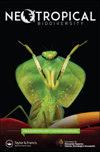Caracterización de poblaciones de especies endémicas en bosque tropical seco semideciduo. Parque Nacional Machalilla, Manabí, Ecuador
IF 0.8
Q4 ECOLOGY
引用次数: 0
Abstract
Seasonally dry tropical forests are ecosystems of high endemism and floristic diversity, but they have been relatively not well-studied ecosystems and are very much threatened by anthropic pressures. This study aimed to evaluate the dendrometric and horizontal structure characteristics of the population of 12 endemic plant species in the semideciduous forest of the Equatorial Pacific Coastal Cordillera of the Machalilla National Park, Manabí, Ecuador. This is one of the most extensive protected areas on the Ecuadorian coast, located in the Tumbes-Chocó-Magdalena biogeographic region. It is considered one of the 25 hotspots worldwide. We selected 12 species that hypothetically co-exist in this semideciduous forest (Bursera graveolens, Eriotheca ruizii, Handroanthus chrysanthus, Ziziphus thyrsiflora, Geoffroea spinosa, Myroxylon balsamum, Priogymnanthus apertus, Melicoccus bijugatus, Nectandra reticulata, Simira ecuadorensis, Coccoloba ruiziana, Klarobelia lucida). We studied five 2500 m2 transects, where dendrometric variables (tree height, diameter at breast height-DBH, basal area, altimetric and diameter classes) were evaluated. We evaluated the horizontal structure variables of populations like absolute/relative abundance, dominance and frequency, and the importance value index (IVI and IVN). In 12,500 m2, the results identified 331 individuals. M. balsamum was the highest species (9.41 m), while E. ruizii had the highest DBH (21.03 cm) and the biggest basal area (0.05 m2). The species with the highest absolute/relative abundance and frequency were S. ecuadorensis and H. chrysanthus, and the latter had the highest absolute dominance (1.23 m2•ha−1). S. ecuadorensis presented the highest importance value index based on 100 and 300, followed by H. chrysanthus and Z. thyrsiflora. P. apertus, M. balsamum, E. ruizii and C. ruiziana obtained intermediate values. The least ecological weight was for N. reticulata, K. lucida, M. bijugatus and G. spinosa. No B. graveolens individuals were observed in the studied transects in this forest because this species was found at altitudes < 240 m a.s.l. The results of the altimetric and diameter classes indicated that the studied sector corresponds to a relatively young secondary forest affected by natural and anthropic factors.热带干燥半落叶林中特有物种种群的特征。厄瓜多尔马纳比马查利拉国家公园
季节性干燥的热带森林是具有高度地方性和植物多样性的生态系统,但它们相对来说还没有得到充分的研究,并且受到人为压力的极大威胁。研究了厄瓜多尔马查利亚国家公园(Manabí)赤道太平洋海岸科迪勒拉半落叶林中12种特有植物的树形特征和水平结构特征。这是厄瓜多尔海岸最广泛的保护区之一,位于Tumbes-Chocó-Magdalena生物地理区域。它被认为是全球25个热点之一。我们选择了12种假设共存的半落叶林中物种(Bursera graveolens、Eriotheca ruizii、Handroanthus chrysanthus、Ziziphus thysiflora、Geoffroea spinosa、Myroxylon balsamum、Priogymnanthus apertus、Melicoccus bijugatus、Nectandra reticulata、Simira ecuadorensis、Coccoloba ruiziana、Klarobelia lucida)。我们研究了5个2500平方米的样带,其中树木测量变量(树高、胸径、基底面积、高程和直径等级)进行了评估。我们评估了种群的绝对/相对丰度、优势度和频度以及重要值指数(IVI和IVN)等水平结构变量。在12500平方米的范围内,鉴定出331个个体。香茅最高(9.41 m),瑞子最高(21.03 cm),基底面积最大(0.05 m2)。绝对/相对丰度和频率最高的种是厄瓜多尔花和菊花,菊花的绝对优势度最高(1.23 m2•ha−1)。重要值指数分别为100和300,厄瓜多尔花最高,菊花次之,百香草次之。白花、香脂、桂花和桂花均为中等值。生态重最小的是网纹田鼠、绿光田鼠、双柳田鼠和棘田鼠。由于该树种主要分布在海拔< 240 m的地区,故在研究样带中未发现白杨个体。海拔和直径分级结果表明,研究区属于受自然和人为因素影响的相对年轻的次生林。
本文章由计算机程序翻译,如有差异,请以英文原文为准。
求助全文
约1分钟内获得全文
求助全文
来源期刊

Neotropical Biodiversity
Environmental Science-Ecology
CiteScore
1.80
自引率
0.00%
发文量
39
审稿时长
24 weeks
 求助内容:
求助内容: 应助结果提醒方式:
应助结果提醒方式:


